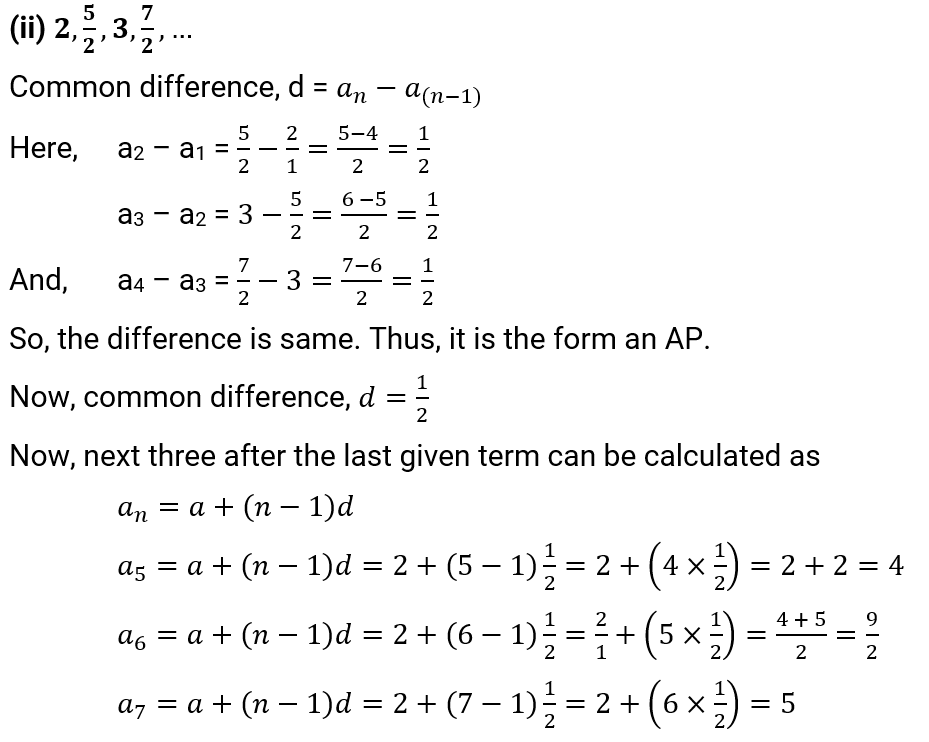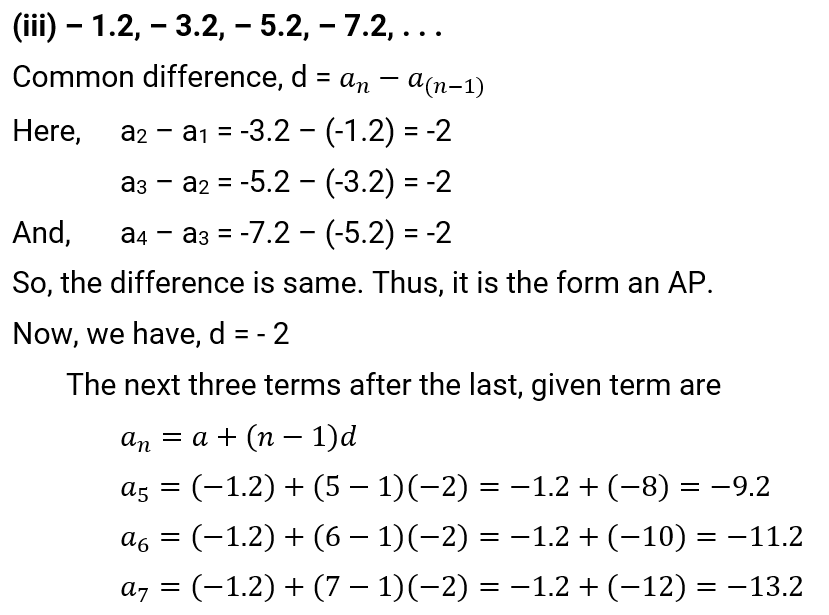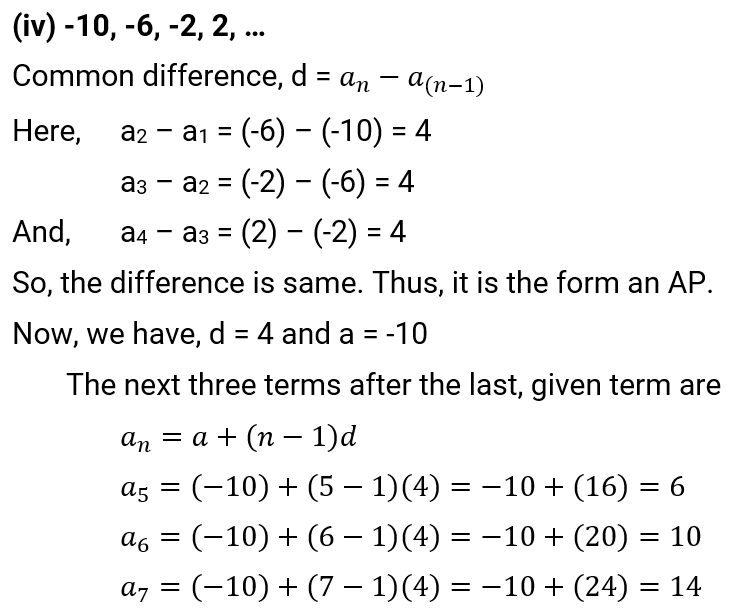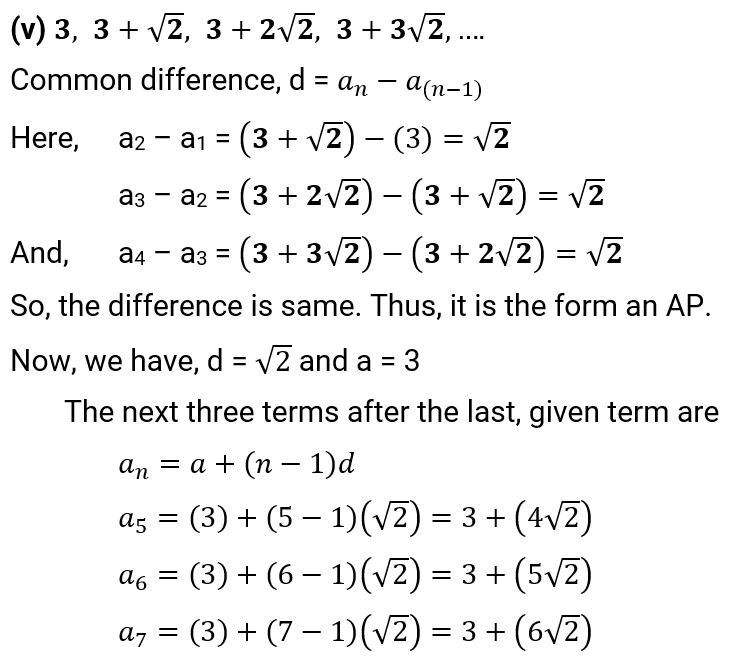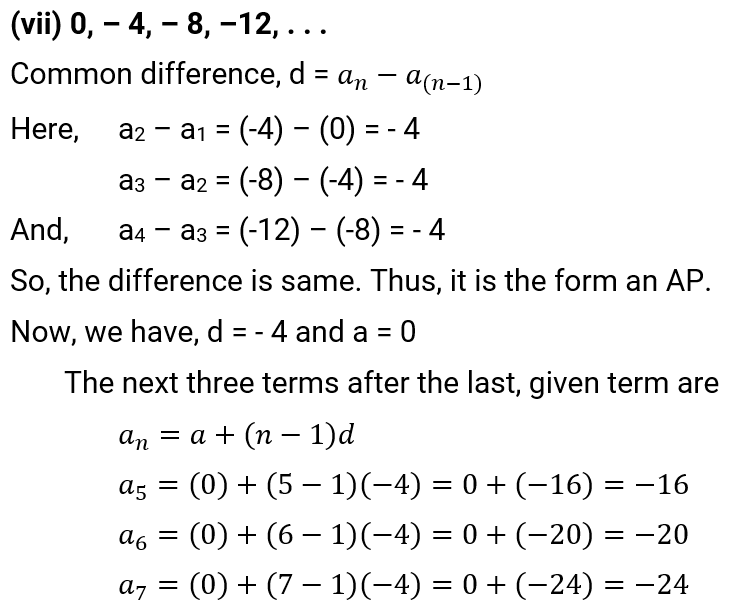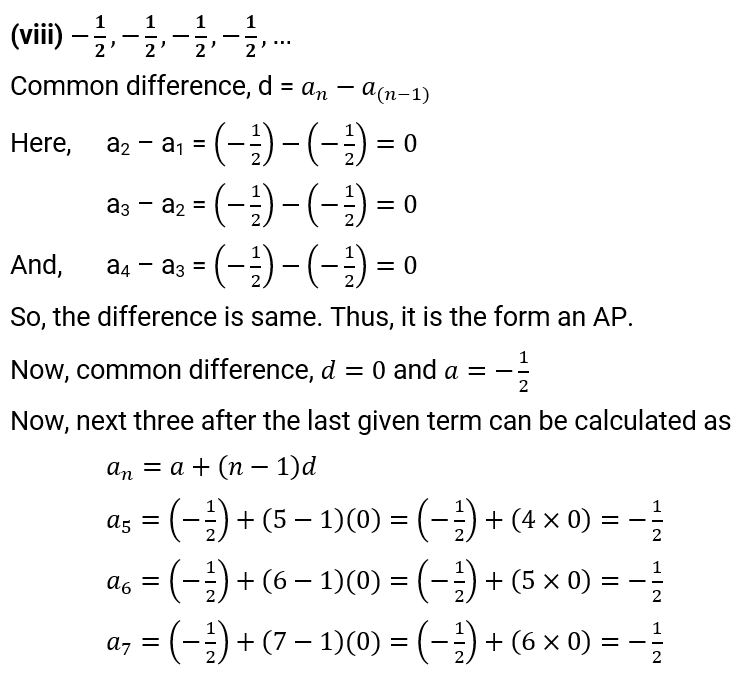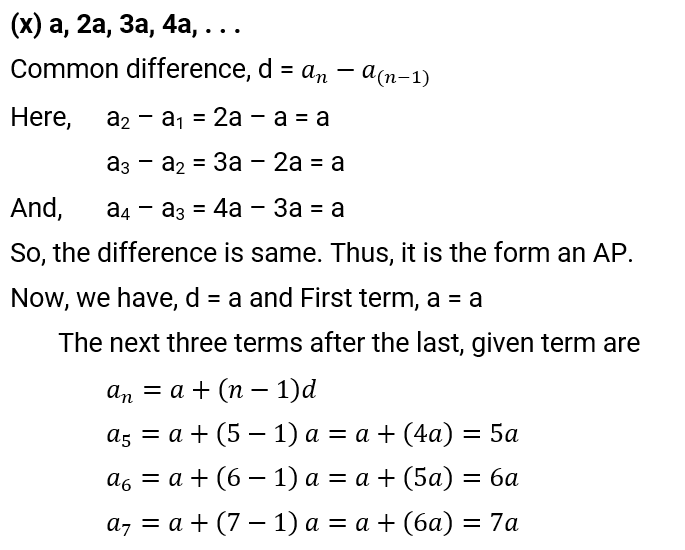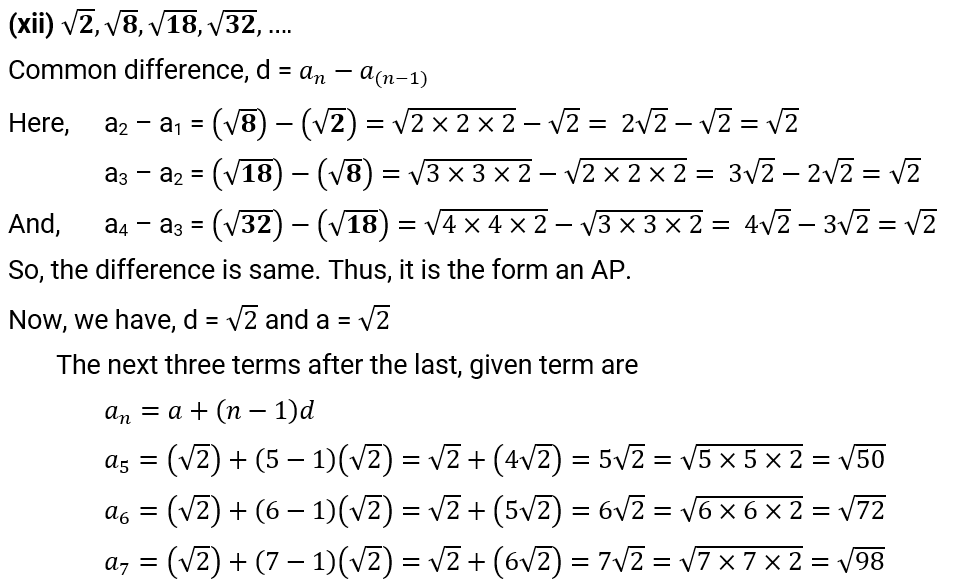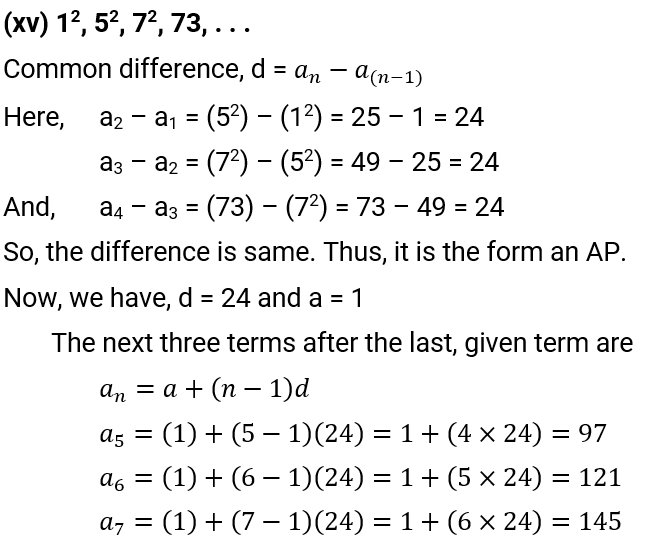NCERT Solution For Class 10, Maths, Chapter 5 Arithmetic Progressions, Exercise 5.1 has questions related basics of the this chapter. With the help of suitable formula, students can easily solve all the problems. Solutions of class 10 , maths chapter 5 , exercise 5.1 is given below.
Table of Contents
Toggle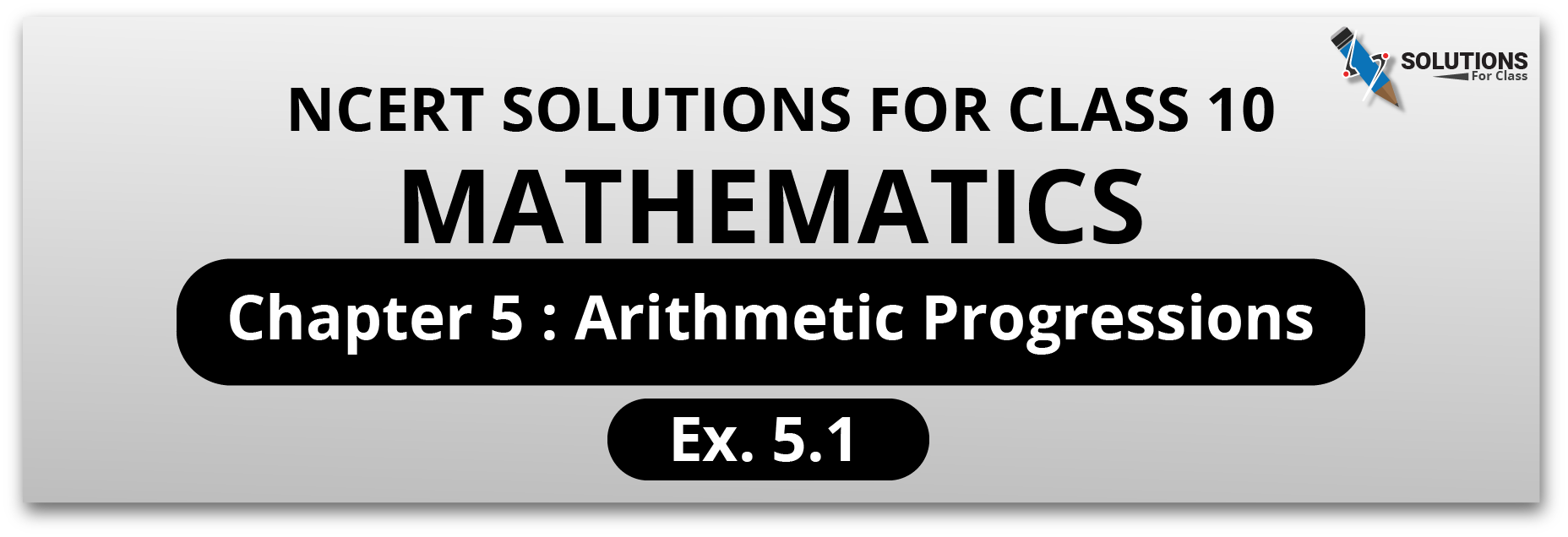
Class 10, Maths, Chapter 5, Exercise 5.1 Solutions
Q.1. In which of the following situations, does the list of numbers involved make an arithmetic progression, and why?
(i) The taxi fare after each km when the fare is ₹ 15 for the first km and ₹ 8 for each additional km.
(ii) The amount of air present in a cylinder when a vacuum pump removes of the air remaining in the cylinder at a time.
(iii) The cost of digging a well after every metre of digging, when it costs `₹150 for the first metre and rises by ₹ 50 for each subsequent metre.
(iv) The amount of money in the account every year, when ₹ 10000 is deposited at compound interest at 8 % per annum.
Ans:
(i) According to the statement, the fare
1 km = Rs 15
2 km = Rs (15+8) = 23
3 km = Rs [15+(2×8)] = 31
4 km = Rs [15 + (3 x 8)] = 39
Now, we have series, 15, 23, 31, 39 ……….
Calculation of common difference,
d = 23 – 15 = 8
d = 31 – 23 = 8
d = 39 – 31 = 8
Since the common difference is same. So, it is an AP
(ii) Let the amount of air present in the cylinder 64 liter. Now, each time ¼th air of total air removed by vacuum pump. Therefore,
64 liter
= 64 – $\left( \frac{1}{4}\times 64 \right)$ = 64 – 16 = 48 litre
= 48 – $\left( \frac{1}{4}\times 48 \right)$ = 48 – 12 = 36 litre
= 36 – $\left( \frac{1}{4}\times 36 \right)$ = 36 – 9 = 27 litre
Now, we have series,64, 48, 36, 27 ……….
Calculation of common difference,
d = 48 – 64 = -16
d = 36 – 48 = -12
d = 27 – 36 = – 9
Since the common difference is not same. So, it not AP.
(iii) According to the statement, the cost of digging in Rs for –
1 m = 150
2 m = (150 + 50) = 200
3 m = [150 + (2 x 50)] = 250
4 m = [150 + (3 x 50)] = 300
Now, we have series, 150, 200, 250, 300 ……….
Calculation of common difference,
d = 200 – 150 = 50
d = 250 – 200 = 50
d = 300 – 250 = 50
Since the common difference is same. So, it is an AP
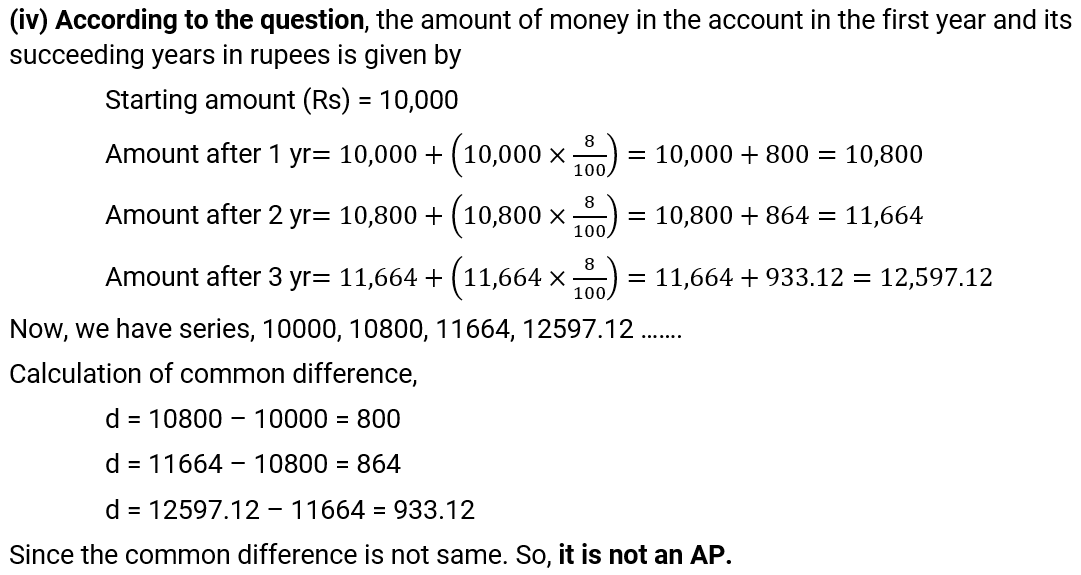
Q.2. Write first four terms of the AP, when the first term a and the common difference d are given as follows:
(i) a = 10, d = 10
(ii) a = –2, d = 0
(iii) a = 4, d = – 3
(iv) a = – 1, d = $\frac{1}{2}$
(v) a = – 1.25, d = – 0.25
Ans: We know that if the first term is a and the common difference is d, then
a, a + d, a i- 2d, a + 3d, … represents an AP for different values of a and d
(i) Putting a = 10, d = 10, we get
an = a + (n-1) d
a1 = 10 + (1-1) 10 = 10
a2 = 10 + (2-1) 10 = 20
a3 = 10 + (3-1) 10 = 30
a4 = 10 + (4-1) 10 = 40
So, the required AP = 10, 20, 30, 40………
(ii) Putting a = 2, d = 0
an = a + (n-1) d
a1 = – 2 + (1-1) 0 = – 2
a2 = – 2 + (2-1) 0 = -2
a3 = – 2 + (3-1) 0 = -2
a4 = – 2 + (4-1) 0 = -2
So, the required AP = -2, -2, -2, -2, ………
(iii) Putting a = 4, d = – 3
an = a + (n-1) d
a1 = 4 + (1-1) -3 = 4
a2 = 4 + (2-1) -3 = 1
a3 = 4 + (3-1) -3 = -2
a4 = 4 + (4-1) -3 = -5
So, the required AP = 4, 1, -2, -5 ………
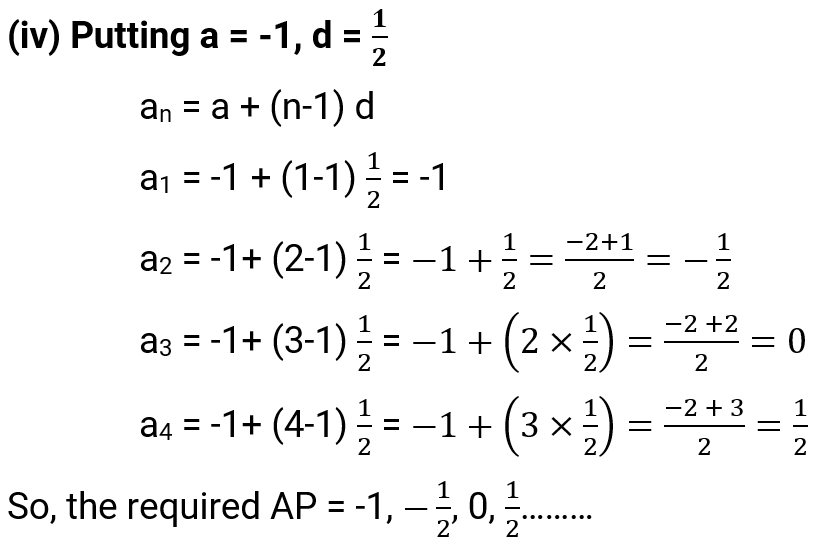
(v) Putting a = -1.25, d = – 0.25
an = a + (n-1) d
a1 = -1.25 + (1-1) – 0.25 = -1.25
a2 = -1.25 + (2-1) – 0.25 = -1.50
a3 = -1.25 + (3-1) – 0.25 = -1.75
a4 = -1.25 + (4-1) – 0.25 = – 2.0
So, the required AP = -1.25, -1.50, -1.75, -2.0 ………
Q.3. For the following APs, write the first term and the common difference:
(i) 3, 1, – 1, – 3, . . .
(ii) – 5, – 1, 3, 7, . . .
(iii) $\frac{1}{3},\frac{5}{3},\frac{9}{3},\frac{13}{3}…..$
(iv) (iv) 0.6, 1.7, 2.8, 3.9, . . .
Ans: (i) The given AP is 3, 1,-1,- 3, …
First term, a = 3
Common difference, d = a2 – a1 = 1 – 3 = -2
Clearly, a = 3 and d = – 2.
(ii) The given AP is- 5,-1, 3, 7, …
First term, a = -5
Common difference, d = a2 – a1 = -1 – (-5) = 4
Clearly, a =- 5 and d = 4
(iii) The given AP is $\frac{1}{3},\frac{5}{3},\frac{9}{3},\frac{13}{3}…..$
First term, a = $\frac{1}{3}$
Common difference, d = a2 – a1 =$\frac{5}{3}-\frac{1}{3}=\frac{5-1}{3}=\frac{4}{3}$
Clearly, a = $\frac{1}{3}$and d = $\frac{4}{3}$
(iv) The given AP is 0.6, 1.7, 2.8, 3.9, …
First term, a = 0.6
Common difference, d = a2 – a1 = 1.7 – 0.6 = 1.1
Clearly, a = 0.6 and d = 1.1
Q.4. Which of the following are APs ? If they form an AP, find the common difference d and write three more terms.
(i) 2, 4, 8, 16, . . .
(ii) $2,\frac{5}{2},3,\frac{7}{2},….$
(iii) – 1.2, – 3.2, – 5.2, – 7.2, . . .
(iv) -10, -6, -2, 2,…
(v) $3,\,\,3+\sqrt{2},\,\,3+2\sqrt{2},\,\,3+3\sqrt{2},……$
(vi) 0.2, 0.22, 0.222, 0.2222, . . .
(vii) 0, – 4, – 8, –12, . . .
(viii) $-\frac{1}{2},-\frac{1}{2},-\frac{1}{2},-\frac{1}{2},….$
(ix) 1, 3, 9, 27, . . .
(x) a, 2a, 3a, 4a, . . .
(xi) a, a2, a3, a4, . . .
(xii) $\sqrt{2},\sqrt{8},\sqrt{18},\sqrt{32},$
(xiii) $\sqrt{3},\sqrt{6},\sqrt{9},\sqrt{12},$
(xiv) 12, 32, 52, 72, . . .
(xv) 12, 52, 72, 73, . . .
Ans:
(i) 2, 4, 8, 16, . . .
Common difference, d =
Here, a2 – a1 = 4 -2 = 2
a3 – a2 = 8 – 4 = 4
And, a4 – a3 = 16 – 8 = 8
So, the difference is not same. Thus, 2, 4, 8, 16, ….. does not form an AP.
